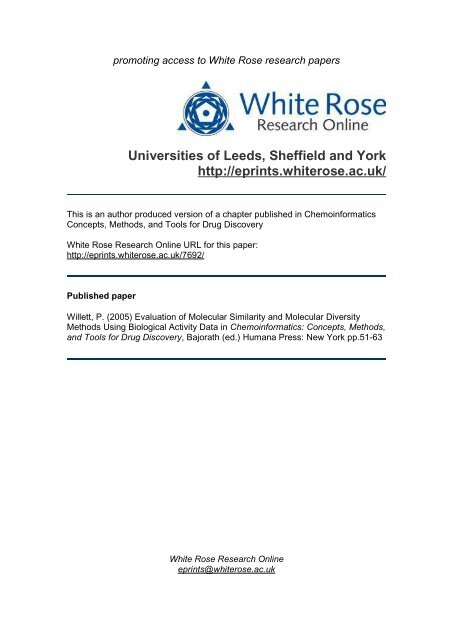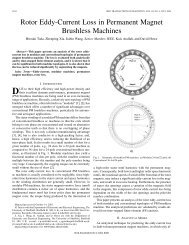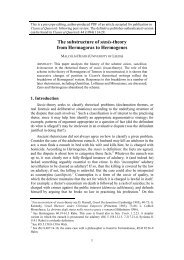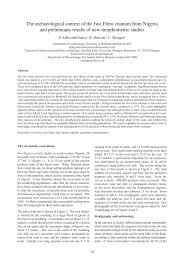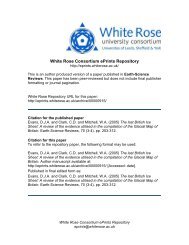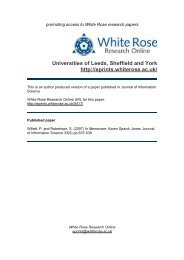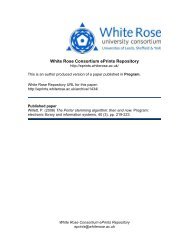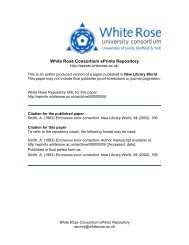7692_willet.pdf (PDF) - White Rose Research Online
7692_willet.pdf (PDF) - White Rose Research Online
7692_willet.pdf (PDF) - White Rose Research Online
Create successful ePaper yourself
Turn your PDF publications into a flip-book with our unique Google optimized e-Paper software.
promoting access to <strong>White</strong> <strong>Rose</strong> research papers<br />
Universities of Leeds, Sheffield and York<br />
http://eprints.whiterose.ac.uk/<br />
This is an author produced version of a chapter published in Chemoinformatics<br />
Concepts, Methods, and Tools for Drug Discovery<br />
<strong>White</strong> <strong>Rose</strong> <strong>Research</strong> <strong>Online</strong> URL for this paper:<br />
http://eprints.whiterose.ac.uk/<strong>7692</strong>/<br />
Published paper<br />
Willett, P. (2005) Evaluation of Molecular Similarity and Molecular Diversity<br />
Methods Using Biological Activity Data in Chemoinformatics: Concepts, Methods,<br />
and Tools for Drug Discovery, Bajorath (ed.) Humana Press: New York pp.51-63<br />
<strong>White</strong> <strong>Rose</strong> <strong>Research</strong> <strong>Online</strong><br />
eprints@whiterose.ac.uk
1<br />
Contribution to Methods in Molecular Biology<br />
Full title: The Evaluation Of Molecular Similarity And Molecular Diversity Methods<br />
Using Biological Activity Data<br />
Running title: Evaluation Of Similarity And Diversity Methods<br />
Author: Peter Willett<br />
Degrees: MA, MSc, PhD, DSc<br />
Affiliation and contact details: Krebs Institute for Biomolecular <strong>Research</strong> and<br />
Department of Information Studies, University of Sheffield, Western Bank, Sheffield<br />
S10 2TN, UK. Email: p.<strong>willet</strong>t@sheffield.ac.uk. Phone: +44-114-2222633. Fax:<br />
+44-114-2780300<br />
Abstract. This paper reviews the techniques available for quantifying the<br />
effectiveness of methods for molecule similarity and molecular diversity, focusing in<br />
particular on similarity searching and on compound selection procedures. The<br />
evaluation criteria considered are based on biological activity data, both qualitative<br />
and quantitative, with rather different criteria needing to be used depending on the<br />
type of data available.<br />
Keywords. Chemical database; Compound selection; Library design; Molecular<br />
diversity; Molecular similarity; Neighbourhood behaviour; Similar property principle;<br />
Similarity searching
2<br />
1. Introduction<br />
The concepts of molecular similarity (1-3) and molecular diversity (4, 5) play<br />
important roles in modern approaches to computer-aided molecular design.<br />
Molecular similarity provides the simplest, and most widely used, method for virtual<br />
screening and underlies the use of clustering methods on chemical databases.<br />
Molecular diversity analysis provides a range of tools for exploring the extent to<br />
which a set of molecules spans structural space, and underlies many approaches to<br />
compound selection and to the design of combinatorial libraries. Many different<br />
similarity and diversity methods have been described in the literature, and new<br />
methods continue to appear. This raises the question of how one can compare<br />
different methods, so as to identify the most appropriate method(s) for some particular<br />
application: this paper provides an overview of the ways in which this can be carried<br />
out, illustrating such comparisons by, principally, our experience of similarity and<br />
diversity studies that have been carried out in the Chemoinformatics <strong>Research</strong> Group<br />
at the University of Sheffield.<br />
There are two bases for the comparison of similarity and diversity methods. It<br />
is possible to compare the efficiency of methods, i.e., the resources, typically<br />
computer time and computer memory, necessary for the completion of processing.<br />
Considerations of efficiency, in particular theoretical analyses of computational<br />
complexity, are important in that they can serve to identify methods that are unlikely<br />
to be applicable given the rapidly increasing sizes of current and planned chemical<br />
datasets. Here, however, we restrict ourselves to comparing the effectiveness of<br />
similarity and diversity methods, i.e., the extent to which a method is able to satisfy<br />
the user’s requirements in terms of identifying similar or diverse sets of compounds.<br />
More specifically, we focus on evaluation criteria based on the availability of<br />
bioactivity data for the molecules that are being processed, where the data can either<br />
be qualitative, i.e., a categorical (usually binary) variable, or quantitative, i.e., a real-<br />
valued variable. The discussion here considers only the criteria that can be used for<br />
comparative studies: the reader is referred elsewhere for the results of such studies.<br />
2. Methods<br />
2.1. Molecular Similarity Methods<br />
2.1.1. Introduction
3<br />
The basic concept of molecular similarity has many applications (1,2) but we focus<br />
here on its use for similarity-based virtual screening, which is often referred to as<br />
similarity searching (3). Here, a user specifies a target structure that is characterised<br />
by one or more structural descriptors, and this set is compared with the corresponding<br />
sets of descriptors for each of the molecules in the database. These comparisons<br />
enable the calculation of a measure of similarity, i.e., the degree of structural<br />
relatedness, between the target structure and each of the database structures, and the<br />
latter are then sorted into order of decreasing similarity with the target. The output<br />
from the search is a ranked list in which the structures that are calculated to be most<br />
similar to the target structure, the nearest neighbours, are located at the top of the list.<br />
These neighbours form the initial output of the search and will be those that have the<br />
greatest probability of being of interest to the user, given an appropriate measure of<br />
inter-molecular structural similarity.<br />
Many different types of similarity measure have been discussed in the<br />
literature but they generally involve three principal components: the representation<br />
that is used to characterise the molecules that are being compared; the weighting<br />
scheme that is used to assign differing degrees of importance to the various<br />
components of these representations; and the similarity coefficient that is used to<br />
provide a quantitative measure of the degree of structural relatedness between a pair<br />
of structural representations. These three components are closely related and it is<br />
hence most important that a comparative study should seek to ensure that only one of<br />
these components is varied at any one time. For example, only a limited amount of<br />
information might be gained from a comparison of the effectiveness of similarity<br />
searching using binary fingerprints (e.g., those produced by the UNITY or Daylight<br />
software) and the Tanimoto coefficient, with the effectiveness of similarity searching<br />
using a set of computed physicochemical parameters (e.g., those produced by the<br />
MOLCONN-Z or DiverseSolutions software), some particular standardisation method<br />
and the Euclidean distance. Given an appropriate evaluation criterion (as discussed<br />
below), one might be able to decide that one of these approaches gave better results<br />
than the other, but one would not be able to identify the relative contributions of the<br />
various components of the overall similarity measures that were being studied.<br />
The basis for all of the evaluation techniques to be discussed here is what is<br />
commonly referred to as the similar-property principle, which was first stated<br />
explicitly by Johnson and Maggiora in their seminal 1990 book (1). The principle
4<br />
states that structurally-similar molecules are expected to exhibit similar properties. It<br />
is clear that there are many exceptions to the principle as stated (6,7), since even a<br />
small change in the structure of a molecule can bring about a radical change in some<br />
property; for example, replacement of a small alkyl group by a larger one, e.g., methyl<br />
replaced by t-butyl, can mean that a molecule is now too large to fit a binding site.<br />
The principle does, however, provide a general rule of thumb that is very widely<br />
applicable; indeed, if this were not the case, then it would prove difficult indeed to<br />
develop meaningful structure-activity relationships of any sort. If the principle does<br />
hold for a particular dataset, then the top-ranked molecules (which are often referred<br />
to as the nearest neighbours) in a similarity search are expected to have properties<br />
that are related to those of the target structure. We can hence evaluate the<br />
effectiveness of a structurally-based similarity procedure by the extent to which the<br />
similarities resulting from its use mirror similarities in some external property, which<br />
in the context of this paper we take to be biological activity (but could be any type of<br />
chemical, biological or physical property). The next two sections of the paper detail<br />
the ways in which the principle is applied to the analysis of qualitative and<br />
quantitative datasets.<br />
2.1.2. Use of qualitative data<br />
In what follows, we shall adopt ideas and terminology from that part of<br />
computer science that is normally referred to as information retrieval (8-10). The<br />
measurement of search effectiveness has played a large part in the development of<br />
information retrieval (or IR) systems, whose principal aim is to identify as many<br />
documents as possible that are relevant to a user’s query whilst simultaneously<br />
minimising the number of non-relevant documents that are retrieved. It is possible to<br />
apply many of these measures to the evaluation of chemical retrieval systems, where<br />
one wishes to identify as many molecules as possible that have the same activity as<br />
the target structure whilst simultaneously minimising the number of inactive<br />
molecules that are retrieved.<br />
The relationship between IR and chemical similarity searching is discussed in<br />
detail by Edgar et al. (11) who summarise the various effectiveness measures in terms<br />
of the 2×2 contingency table shown in Table 1. In this table, it is assumed that a<br />
search has been carried out resulting in the retrieval of the n nearest neighbours at the<br />
top of the ranked output. Assume that these n nearest neighbours include a of the A
5<br />
active molecules in the complete database, which contains a total of N molecules.<br />
Then the recall, R, is defined to be the fraction of the active molecules that are<br />
retrieved, i.e.,<br />
a<br />
R = ,<br />
A<br />
and the precision, P, is defined to be the fraction of the retrieved molecules that are<br />
active, i.e.,<br />
a<br />
P = .<br />
n<br />
A retrieval mechanism should seek to maximise both the recall and the precision of a<br />
search so that, in the ideal case, a user would be presented with all of the actives in the<br />
database without any additional inactives: needless to say, this ideal is very rarely<br />
achieved in practice.<br />
It is inconvenient to have to specify two measures, i.e., recall and precision, to<br />
quantify the effectiveness of a search. The Merck group have made extensive use of<br />
the enrichment factor, i.e., the number of actives retrieved relative to the number that<br />
would have been retrieved if compounds had been picked from the database at<br />
random (12). Thus, using the notation of Table 1, the enrichment factor at some<br />
point, n, in the ranking resulting from a similarity search is given by<br />
a / n<br />
.<br />
A / N<br />
Note that since A/N is a constant, the enrichment is monotonic with precision. Rather<br />
than specifying the enrichment at some specific point in the ranking, e.g., the top-<br />
1000 positions, it can alternatively be specified at that point where some specific<br />
fraction, e.g., 50%, of the actives have been retrieved. Examples of the use of<br />
enrichment factors are provided by Sheridan et al. (12) and Gillet et al. (13).<br />
Alternatively, Güner and Henry (14) have introduced the G-H score, which is<br />
a weighted average of recall and precision. The score was originally developed for<br />
evaluating the effectiveness of 3D database searches but can be applied to the<br />
evaluation of any sort of search for which qualitative bioactivity data are available.<br />
Using the previous notation, the G-H score is defined to be<br />
α P + βR<br />
,<br />
2
6<br />
where α and β are weights describing the relative importance of recall and precision.<br />
The lowerbound for the G-H score is zero; if both weights are set to unity, then the<br />
score is simply the arithmetic mean of recall and precision, i.e.,<br />
P + R<br />
.<br />
2<br />
Examples of the use of the G-H score are provided by Güner and Henry (15) and by<br />
Raymond and Willett (16), while Edgar et al. discuss other combined measures that<br />
can be used for chemical similarity searching (11).<br />
At least three alternative approaches have been widely used. First, the<br />
Sheffield group has generally quoted the mean numbers of active compounds<br />
identified in some fixed number of the top-ranked nearest neighbours, when averaged<br />
over a set of searches for bioactive target structures. An early example of the use of<br />
this approach is a comparison of 3D similarity measures based on inter-atomic<br />
distances (17), with Briem and Lessel providing a more recent application in their<br />
extended comparison of virtual screening methods (18). The use of a fixed cut-off<br />
means that this measure is basically a reformulation of precision, which is entirely<br />
acceptable in the early stages of a discovery programme, when the immediate need is<br />
to identify additional active molecules; however, the measure takes no account of<br />
recall, which may be an important factor in a detailed comparative study of the<br />
behaviour of different similarity measures. A second, and alternative, ‘leave-one-out’<br />
classification approach assumes that the activity of one of the molecules in the<br />
database, X, is unknown. A similarity search is carried out using X as the target<br />
structure and the top-x (where x is odd) nearest neighbours identified. The activity or<br />
inactivity of X is then predicted on the basis of a majority vote (hence the requirement<br />
for an odd number) of the known activities of the selected nearest neighbours. This<br />
process is repeated for each of the N molecules in turn (or just the A active molecules<br />
in many cases), yielding a contingency table of the sort shown in Table 2. Various<br />
statistics can be produced from the elements of this table: perhaps the most common<br />
is Cohen’s kappa statistic (19). This is defined to be<br />
O − E<br />
,<br />
1−<br />
E<br />
where O and E are the observed and expected accuracies of classification. These<br />
accuracies can be defined in terms of the elements of Table 2 as follows:
7<br />
i + l<br />
O = , and<br />
n<br />
( i + k)(<br />
i + j)<br />
+ ( j + l)(<br />
k + l)<br />
= .<br />
n<br />
E 2<br />
There are many variants on this basic idea, such as the weighted kappa described by<br />
Cohen himself (20) and the Rand statistic (21), which is perhaps the most widely used<br />
of the measures available for comparing different clusterings of the same set of<br />
objects.<br />
Finally, it may be of interest to study the performance of a measure across the<br />
entire ranking resulting from a similarity search, rather than the performance for some<br />
fixed number of nearest neighbours. In this case, the most popular approach is the use<br />
of a cumulative recall graph, which plots the recall against the number of compounds<br />
retrieved (i.e., a/A against n using the notation of Table 1). The best-possible such<br />
graph would hence be one in which the A relevant documents are at the top of the<br />
ranking, i.e., at rank-positions 1, 2, 3…A (or at rank-positions, N-A+1, N-A+2, N-<br />
A+3…N in the case of the worst-possible ranking). The use of such diagrams is<br />
exemplified by studies of similarity searching using physicochemical descriptors (12)<br />
and of a range of virtual screening methods for searching agrochemical datasets (22).<br />
The cumulative recall plot is closely related to the receiver operating characteristic<br />
(ROC) curves that are widely used in signal detection and classification problems<br />
(23). An ROC curve plots the true positives against the false positives for different<br />
classifications of the same set of objects; this corresponds to plotting a against n-a<br />
using the notation of Table 1, and thus the shape of an ROC curve tends to the shape<br />
of a cumulative recall plot when n>>a. An example of the use of ROC plots in<br />
chemoinformatics is provided by the work of Cuissart et al. on similarity-based<br />
methods for the prediction of biodegradability (24).<br />
2.1.3. Use of quantitative data<br />
The similar property principle can also be applied to the analysis of datasets<br />
for which quantitative bioactivity data are available, most commonly using a simple<br />
modification of the ‘leave-one-out’ classification approach described above. Here,<br />
the predicted property value for the target structure X, P(X), is taken to be the<br />
arithmetic mean of the observed property values of the selected nearest neighbours.<br />
This procedure results in the calculation of a P(X) value for each of the N structures in<br />
a dataset, and an overall figure of merit is then obtained by calculating the product
8<br />
moment correlation coefficient between the sets of N observed and N predicted<br />
values. This approach can equally well be applied to the evaluation of clustering<br />
methods, with the predicted values here being the mean of the other compounds in the<br />
cluster containing the chosen molecule, X.<br />
This application of the similar property principle was pioneered by Adamson<br />
and Bush (25, 26) and has since been very extensively applied. For example, Willett<br />
and Winterman used it in one of the first detailed comparisons of measures for<br />
similarity searching (27) and it also formed the basis for Brown and Martin’s much-<br />
cited comparison of clustering methods and structural descriptors for compound<br />
selection (28).<br />
2.2. Molecular Diversity Methods<br />
2.2.1. Introduction<br />
The principal aim of molecular diversity analysis is to identify structurally<br />
diverse (synonyms are dissimilar, disparate and heterogeneous) sets of compounds<br />
that can then be tested for bioactivity, the assumption being that a structurally diverse<br />
set will generate more structure-activity information than will a set of compounds<br />
identified at random. The sets of compounds can be selected from an existing<br />
corporate or public database, or can be the result of a systematic combinatorial library<br />
design process (4, 5).<br />
Many of the comments that were made in Section 3.1.1 regarding similarity<br />
measures are equally applicable to diversity methods, in that the latter involve<br />
knowledge of the degree of dissimilarity or distance between pairs, or larger groups,<br />
of molecules. Here, however, there is also the need to specify a selection algorithm,<br />
which uses the computed dissimilarities to identify the final structurally diverse set of<br />
compounds, and there may also be a diversity index, which quantifies the degree of<br />
diversity in this set. It is thus important, as with similarity measures, to isolate the<br />
effect of the various components of the diversity methods that are being analysed in a<br />
comparative study. There have been many such comparisons, e.g., (28-33). Here, we<br />
focus on diversity indices since it is these that measure the overall effectiveness of a<br />
method (in fact, while an index is computed once a selection algorithm has completed<br />
its task, there are some types of algorithm that seek explicitly to optimise the chosen<br />
index, so that the current value of the index drives the operation of the selection<br />
algorithm).
9<br />
Many of the early evaluations of the effectiveness of diversity methods used<br />
structure-based diversity indices, such as functions of inter-molecular dissimilarities<br />
in the context of distance-based selection methods or of the numbers of occupied cells<br />
in partition-based selection methods (4). A wide range of such indices has been<br />
reported, as discussed in the excellent review by Waldman et al. (34). They do,<br />
however, have the limitation that they quantify diversity in chemical space, whereas<br />
the principal rationale for molecular diversity methods is to maximise diversity in<br />
biological space (35), and we hence focus here on indices that take account of<br />
biological activity.<br />
2.2.2. General screening programmes<br />
We have noted the importance of the similar property principle, which would<br />
imply that a set of compounds exhibiting some degree of structural redundancy, i.e.,<br />
containing molecules that are near neighbours of each other, will also exhibit some<br />
degree of biological redundancy; a structurally diverse subset, conversely, should<br />
maximise the number of types of activity exhibited by its constituent molecules. It<br />
should thus be possible to compare the effectiveness of different structure-based<br />
selection methods by the extent to which they result in subsets that exhibit as many as<br />
possible of the types of activity present in the parent dataset. Maximising biological<br />
diversity in this way is the principal aim of general screening programs, which aim to<br />
select molecules from a database (or design combinatorial libraries for synthesis) that<br />
exhibit the widest possible range of different types of activity. An obvious measure<br />
of the diversity of the resulting compounds is hence the number of types of activity<br />
exhibited by them. This can be easily tested using one of the public databases that<br />
contain both chemical structures and pharmacological activities, such as the MACCS<br />
Drug Data Report (MDDR, at URL http://www.mdli.com/products/mddr.html) or the<br />
World Drugs Index (WDI, at URL<br />
http://www.derwent.com/worlddrugindex/index.html) databases. Thus, in one of the<br />
earliest comparative studies of methods for comparing diverse database subsets,<br />
Snarey et al. compared a range of maximum dissimilarity and sphere exclusion<br />
methods for dissimilarity-based compound selection by means of the number of<br />
different types of activity present in subsets chosen from molecules in the WDI<br />
database (31); this approach has been adopted in several subsequent studies.
10<br />
2.2.3. Focused screening programmes<br />
In a focused screening programme, the aim is to select molecules from a<br />
database (or design combinatorial libraries for synthesis) that provide the maximum<br />
amount of information about the relationships that exist between structural features<br />
and some specific type of biological activity. If this data is qualitative in nature, then<br />
a simple count of the active molecules present will suffice to quantify the degree of<br />
biological diversity. However, at least some account must additionally be taken of the<br />
chemical diversity that is present, to avoid a high level of diversity being ascribed to a<br />
cluster of highly similar molecules (such as “me too” or “fast follower” compounds in<br />
a drug database). An example of this approach is a comparison of binning schemes<br />
for cell-based compound selection by Bayley and Willett (36) that selected one<br />
molecule from each cell in a grid (thus ensuring that the selected molecules were<br />
structurally diverse) and then noted how many of these selected molecules were<br />
bioactive (thus quantifying the biological diversity).<br />
Once interest has been focused on some small volume of structural space,<br />
large numbers of molecules are synthesised and tested (and often re-tested in the case<br />
of HTS data), and the results of these experiments used to develop a quantitative<br />
structure-activity relationship (QSAR). It has for long been claimed that the use of<br />
diverse sets of compounds will enable more robust QSARs to be developed than can<br />
be developed using randomly-chosen training sets. That this is in fact the case has<br />
been demonstrated recently by Golbraikh and Tropsha (37), and one can hence<br />
quantify the effectiveness of a compound selection method by the predictive power of<br />
the QSARs that can be derived from the compounds selected by that method.<br />
Quantitative bioactivity data also lies at the heart of the neighbourhood behaviour<br />
approach of Patterson et al. (33), which is analogous to the similar property principle<br />
but emphasises the absolute differences in descriptor values and in bioactivity values,<br />
rather than the values themselves. Specifically the authors state that a meaningful<br />
descriptor for diversity analysis is one for which “small differences in structure do not<br />
(often) produce large differences in biology”, and then use this idea to compare a<br />
wide range of descriptor types by means of a χ² analysis; an improved version of this<br />
analysis is described by Dixon and Merz (38).
11<br />
3. Notes<br />
1. The group in Sheffield has over two decades experience of carrying out<br />
comparative studies of similarity (and, more recently, diversity) methods.<br />
Perhaps the most importance single piece of advice we can give to those<br />
wishing to carry out comparable studies is the need to use a range of types of<br />
data, ideally including both homogeneous and heterogeneous datasets. Only<br />
by so doing can one ensure the robustness and general applicability of the<br />
methods that are being compared. In particular, one would not wish to<br />
encourage the situation that pertained for some time in the QSAR literature,<br />
where a new method was normally developed and tested on a single dataset,<br />
most commonly the set of steroids (39) first popularised by Cramer et al. (40).<br />
2. In like vein, we would recommend the use of more than just one evaluation<br />
measure. That said, it is our experience that different measures usually agree<br />
as to the relative merits of different approaches (unless there are only very<br />
minor differences in effectiveness): even so, it is always worth carrying out<br />
additional analyses to ensure that one’s results are, indeed, independent of the<br />
evaluation criterion that has been adopted.<br />
3. Having criticised the exclusive use of the steroid dataset, it does have the great<br />
References<br />
advantage that it provides a simple basis for comparison with previous work,<br />
and it would be highly desirable if comparable test-sets were available for<br />
similarity and diversity analyses. To some extent, this is already happening<br />
with increasing use being made of the qualitative bioactivity data in the<br />
MDDR and WDI datasets mentioned previously; two other datasets that can<br />
be used for this purpose, and which have the advantage that they are available<br />
for public download, are the cancer and AIDS files produced by the National<br />
Cancer Institute (at URL http://dtp.nci.nih.gov/).<br />
1. Johnson, M. A. and Maggiora, G. M. (eds.) (1990) Concepts and Applications of<br />
Molecular Similarity. Wiley, New York.<br />
2. Dean, P. M. (ed.) (1994) Molecular Similarity in Drug Design. Chapman and Hall,<br />
Glasgow.
12<br />
3. Willett, P., Barnard, J. M. and Downs, G. M. (1998) Chemical similarity searching.<br />
J. Chem. Inf. Comput. Sci. 38, 983--996.<br />
4. Dean, P. M. and Lewis, R. A. (eds.) (1999) Molecular Diversity in Drug Design.<br />
Kluwer, Amsterdam.<br />
5. Ghose, A. K. and Viswanadhan, V. N. (eds.) (2001) Combinatorial Library Design and<br />
Evaluation: Principles, Software Tools and Applications in Drug Discovery. Marcel<br />
Dekker, New York.<br />
6. Kubinyi, H. (1998) Similarity and dissimilarity – a medicinal chemist’s view.<br />
Perspect. Drug. Discov. Design 11, 225--252.<br />
7. Martin, Y. C., Kofron, J. L. and Traphagen, L. M. (2002) Do structurally similar<br />
molecules have similar biological activities? J. Med. Chem. 45, 4350--4358.<br />
8. Salton, G. and McGill, M. J. (1983) Introduction to Modern Information Retrieval.<br />
McGraw-Hill, New York.<br />
9. Frakes, W.B. and Baeza-Yates, R. (eds.) (1992) Information Retrieval: Data<br />
Structures and Algorithms. Prentice Hall, Englewood Cliffs NJ.<br />
10. Sparck Jones, K. and Willett, P. (eds.) (1997) Readings in Information Retrieval.<br />
Morgan Kaufmann, San Francisco CA<br />
11. Edgar, S. J., Holliday, J. D. and Willett, P. (2000) Effectiveness of retrieval in<br />
similarity searches of chemical databases: a review of performance measures. J. Mol.<br />
Graph. Model. 18, 343--357.<br />
12. Kearsley, S. K., Sallamack, S., Fluder, E. M., Andose, J. D., Mosley, R. T. and<br />
Sheridan, R. P. (1996) Chemical similarity using physiochemical property<br />
descriptors. J. Chem. Inf. Comput. Sci. 36, 118--127.<br />
13. Gillet, V. J., Willett, P. and Bradshaw, J. (1998) Identification of biological activity<br />
profiles using substructural analysis and genetic algorithms. J. Chem. Inf. Comput.<br />
Sci. 38, 165--179.<br />
14. Güner, O.F. and Henry, D.R. Formula for determining the “goodness of hit lists” in<br />
3D database searches. At URL<br />
http://www.netsci.org/Science/Cheminform/feature09.html.<br />
15. Güner, O.F. and Henry, D.R. (2000) Metric for analyzing hit lists and<br />
pharmacophores, in Pharmacophore Perception, Development and Use in Drug<br />
Design (Guner, O., ed.), International University Line, La Jolla CA. pp. 193--212<br />
16. Raymond, J. W. and Willett, P. (2002) Effectiveness of graph-based and fingerprint-<br />
based similarity measures for virtual screening of 2D chemical structure databases. J.<br />
Comput.-Aid. Mol. Design 16, 59--71.
13<br />
17. Pepperrell, C. A. and Willett, P. (1991) Techniques for the calculation of three-<br />
dimensional structural similarity using inter-atomic distances. J. Comput.-Aided Mol.<br />
Design 5, 455--474.<br />
18. Briem, H. and Lessel, U. F. (2000) In vitro and in silico affinity fingerprints: finding<br />
similarities beyond structural classes. Perspect Drug Discov. Design 20, 231--244.<br />
19. Cohen, J. A. (1960) A coefficient of agreement for nominal scales. Educ. Psychol.<br />
Measure. 20, 37--46.<br />
20. Cohen, J. A. (1968) Weighted kappa: nominal scale agreement with provision fro<br />
scale disagreement or partial credit. Psychol. Bull. 70, 213--220.<br />
21. Rand, W. M. (1971) Objective criteria for the evaluation of clustering methods. J.<br />
Amer. Stat. Assoc. 66, 846--850.<br />
22. Wilton, D., Willett, P., Mullier, G. and Lawson, K. (2003) Comparison of ranking<br />
methods for virtual screening in lead-discovery programmes. J. Chem. Inf. Comput.<br />
Sci. 43, 469--474.<br />
23. Egan, J. P. (1975) Signal Detection Theory and ROC Analysis, Academic Press, New<br />
York.<br />
24. Cuissart, B., Touffet, F., Crémilleux, Bureau, R. and Rault, S. (2002) The maximum<br />
common substructure as a molecular depiction in a supervised classification context:<br />
experiments in quantitative structure/biodegradability relationships. J. Chem. Inf.<br />
Comput. Sci. 42, 1043--1052.<br />
25. Adamson, G. W. and Bush, J. A. (1973) A method for the automatic classification of<br />
chemical structures. Inf. Stor. Retriev. 9, 561--568.<br />
26. Adamson, G. W. and Bush, J. A. (1975) A comparison of the performance of some<br />
similarity and dissimilarity measures in the automatic classification of chemical<br />
structures. J. Chem. Inf. Comput. Sci. 15, 55--58.<br />
27. Willett, P. and Winterman, V. (1986) A comparison of some measures for the<br />
determination of inter-molecular structural similarity. Quant. Struct.-Activ. Relat. 5,<br />
18--25.<br />
28. Brown, R. D. and Martin, Y. C. (1996) Use of structure-activity data to compare<br />
structure-based clustering methods and descriptors for use in compound selection. J.<br />
Chem. Inf. Comput. Sci. 36, 572--584.<br />
29. Brown, R. D. (1997) Descriptors for diversity analysis. Perspect. Drug Disc. Design<br />
7/8, 31--49.<br />
30. Bayada, D. M., Hamersma, H. and van Geerestein, V. J. (1999) Molecular diversity<br />
and representativity in chemical databases. J. Chem. Inf. Comput. Sci. 39, 1--10.
14<br />
31. Snarey, M., Terret, N. K., Willett, P. and Wilton, D. J. (1997) Comparison of<br />
algorithms for dissimilarity-based compound selection. J. Mol. Graph. Model. 15,<br />
372--385.<br />
32. Matter, H. and Potter, T. (1999) Comparing 3D pharmacophore triplets and 2D<br />
fingerprints for selecting diverse compound subsets. J. Chem. Inf. Comput. Sci. 39,<br />
1211--1225.<br />
33. Patterson, D. E., Cramer, R. D., Ferguson, A. M., Clark, R. D. and Weinberger, L. E.<br />
(1996) Neighbourhood behaviour: a useful concept for validation of “molecular<br />
diversity” descriptors. J. Med. Chem. 39, 3049--3059.<br />
34. Waldman, M., Li, H. and Hassan, M. (2000) Novel algorithms for the optimisation of<br />
molecular diversity of combinatorial libraries. J. Mol. Graph. Model. 18, 412--426.<br />
35. Ferguson, A. M., Patterson, D. E., Garr, C. D. and Underiner, T. L. (1996) Designing<br />
chemical libraries for lead discovery. J. Biomol. Screen. 1, 65--73.<br />
36. Bayley, M. J. and Willett, P. (1999) Binning schemes for partition-based compound<br />
selection. J. Mol. Graph. Model. 17, 10--18.<br />
37. Golbraikh, A. and Tropsha, A. (2002) Predictive QSAR modeling based on diversity<br />
sampling of experimental datasets for the training and test set selection. J. Comput.-<br />
Aid. Mol. Design 16, 357--369.<br />
38. Dixon, S. L. and Merz, K. M. (2001) One-dimensional molecular representations and<br />
similarity calculations: methodology and validation. J. Med. Chem. 44, 3795—3809.<br />
39. Coats, E. A. (1998) The CoMFA steroids as a benchmark dataset for development of<br />
3D QSAR methods. Perspect. Drug Discov. Design 12/14, 199--213.<br />
40. Cramer, R. D., Patterson, D. E. and Bunce, J. D. (1988) Comparative Molecular Field<br />
Analysis (CoMFA). Effect of shape on binding of steroids to carrier proteins. J. Am.<br />
Chem. Soc. 110, 5959--5967.
15<br />
Table 1. Contingency table describing the output of a search in terms of active<br />
molecules and molecules retrieved in a similarity search retrieving n molecules.<br />
Active<br />
Yes No<br />
Retrieved Yes a n-a n<br />
No A-a N-n-A+a N-n<br />
A N-A N<br />
Table 2. Contingency table describing the output of a search in terms of correctly and<br />
incorrectly predicted molecules in a classification experiment classifying n molecules.<br />
Classification<br />
Active Inactive<br />
Truth Active i j i+j<br />
Inactive k l k+l<br />
i+k j+l n


